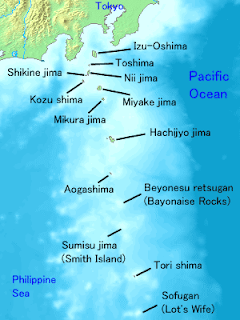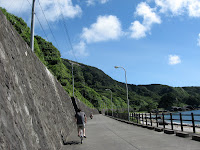This month's big adventure was a trip to the string of islands south of Tokyo called the Izu Islands, or at least that is what foreigners call them. If you google "Izu Islands", you get plenty of hits in English. However, every single student to whom Ryan mentioned the name, returned a blank stare. Many Japanese folks have a vague idea of the closest, biggest island, Oshima, but that is all. (side note: -shima/jima just means "island", so all end with that) I was hopeful that this general lack of knowledge would bode well for a quiet weekend. We decided to go as far as the overnight ferry would take us, which is Kozu shima. We boarded at 11:00 pm in Tokyo and finally got to our island by about 9:00 the next morning. In order to get to farther islands, one must either fly (a few of the islands have landing strips) or take a longer ferry or cruise ship. Incidentally, the next island out, Miyakejima, was recently evacuated for volcanic activity.
The ferry ride itself was actually quite an adventure. Although with enough advance planning (whatever that is), you can book an actual seat or bed, the good majority of the ticket holders (ourselves included) were entitled merely to a place somewhere on the deck. Any place. Good luck with that. Here is your complimentary striped tarp.
Although we were there an hour before departure, we were approximately the 999th ones in line. We slowly streamed onto the boat behind so many large groups with ice chests, fishing poles, surf boards, you name it. Every group threw down their gigantic blue tarps (a la hanami) and quickly made themselves at home. As we started tiptoeing through all their established camp sites looking for a place to call our own, we started to get worried. We split up and kept radioing back to the other with bad news. Even the crappy place behind the exhaust was taken. This was looking very bad. Then I returned to the boat entrance. Because of the way the crowd was getting issued onto the boat and up the stairs, there was a little dead space on the side. I pointed to the space and asked if it was okay. With a quick nod, three groups of us quickly filled in and spread out. It was an awesome spot. We could lean back and watch the Tokyo lights go by.
The next morning we got picked up at the dock in Kozushima by the mama-san from our minshuku (a small hotel in someone's home, like a B&B). Although our plan was to climb Mt. Tenjo, the intense summer heat precluded this. After checking in, cranking the AC and taking a quick nap, we instead rented some bikes and went for a ride around the main part of the island. We headed toward Akazaki, where there is a system of wooden walkways and bridges built around a nice swimming hole and tide pools.
Though the Akazaki area was a little too crowded for our liking (a band of European college kids was loudly making their presence known), we had our pick of any other secluded beach on the coastal road back to town. There were lots of little coves and some very cool geology.
The heat was pretty oppressive, but all the swimming offered a nice break. As did the ferry office down by the pier. Here they graciously provided a big tatami lounging area, vending machines and had the AC turned up high. Ahhh!
Back at our minshuku, we took another nap (yay vacation!) and had a lovely traditional meal of cooked fish, sashimi, tempura, rice and so many little bowls of goodies, all prepared by mama-san.
After dinner we took a stroll down to the beach and went into what appeared to be the only bar on the island. We sat on the upstairs patio looking out at the beach and watched the sun set. After a while, groups of young folks started passing by, each group carrying a bucket and filling it up with water at the fountain in front of us. Sometime later we saw why. We got three separate shows, including some bottle rockets.
The next morning, after a big multi-bowl breakie, we caught our ferry to the next island over, tiny Shikenjima.
We will just have to climb you next time, Tenjo-san...



























































